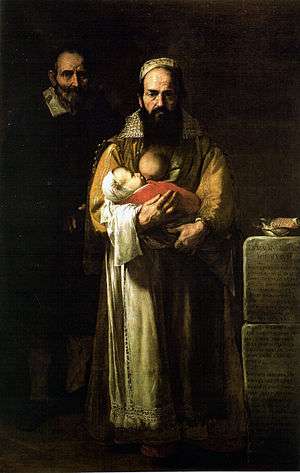Magdalena Ventura with Her Husband and Son
Magdalena Ventura with Her Husband and Son or The Bearded Lady is a 1631 oil on canvas painting by the Spanish artist Jusepe de Ribera. It is now part of the Fundación Casa Ducal de Medinaceli collection and displayed at the Museo Fundación Lerma in Toledo.
| Magdalena Ventura with Her Husband and Son | |
|---|---|
| The Bearded Woman | |
 | |
| Year | 1631 |
| Dimensions | 212 cm (83 in) × 144 cm (57 in) |
| Location | Louvre, Real Academia de Bellas Artes de San Fernando, Hospital de Tavera |
| Owner | Fernando Afán de Ribera |
Description
It shows Magdalena Ventura standing while nursing her baby. Behind her, in the shadows, is her husband, and on the right are two steles. The top one lists the details of their family story in Latin, proclaiming it as A Wonder of Nature.[1] The full text on the top stele is:
EN MAGNV[M] NATVRAE / MIRACVLVM / MAGDALENA VENTVRA EX- / OPPIDO ACVMVLI APVD / SAMNITES VVLGO, EL A-/ BRVZZO REGNI, NEAPOLI-/ TANI ANNVRVM 52 ET / QVOD INSOLENS EST CV[M] / ANNVM 37 AGERET COE- / PIT PUBESCERE EOQVE / BARBA DEMISSA AC PRO- / LIXA EST VI POTIVS
As the second stele with inscription explains, the wonder lies not only in this unusual woman and her beard story, but also in her fertility and the work of the painter and the proud owner who commissioned it. The full text on the lower stele is:
ALCIVIOS MAGISTRI BARBATI / ESSE VIDEATVR QVAM MV- / LIERIS QVAE TRES FILIOS / ANTE AMISERIT QVOS EX / VIRO SVO FELICI DE AMICI / QVEM ADESSE VIDES HA- / BVERAT. JOSEPHVS DE RIBERA HIS- / PANVS CHRISTI CRVCE / INSIGNITVS SVI TEM-/ PORIS ALTER APELLES / IVSSV FERDINANDE II / DVCIS III DE ALCALA NEAPOLI PROREGIS AD / VIVVM MIRE DEPINXIT / XIIIJ KALEND. MART. / ANNO MDCXXXI
The painting was mentioned in various period diaries. All we know about Magdalena today is derived from these quotes and documents referring to the painting itself. The break in the text could be where the family's own story ends and the public story begins. The Duke of Alcalá was moved to commission the painting based on rumors he heard about her. She probably either assisted in the family income or was sole breadwinner by not trimming her beard growth, an aspect implicitly emphasized by the length of her beard compared to the more fashionably trimmed beard of her husband. The painting was part of a gallery of unusual portraits of people with various characteristics that were popular in travelling acts of the period, such as dwarfism. In this case, the center of attention is drawn to hirsutism. Though unusual hair-growth is unrelated to strength, the simple act of standing while nursing was an unusual pose for 17th-century women, and echoes period accounts of strong African women nursing in unusual ways. In his 1602 account of the Gold Coast of Africa, Pieter de Marees mentions the women "who stand up after birth and go about their business, often taking to the streets just days afterwards". His book was the standard text on Africa and was translated in several languages before this painting was made. Either Ribera himself or his patron, the collector Fernando Afán de Ribera, duke of Alcalá de los Gazules, would have seen and read the book.
 'Four Women of Guinea', 1602 illustration by Johann Theodor de Bry, with explanatory text by Pieter de Marees.
'Four Women of Guinea', 1602 illustration by Johann Theodor de Bry, with explanatory text by Pieter de Marees.
Not only has Ribera emphasized her manliness by having her stand while nursing, he shows Magdalena's strength in her hands in the way she grips her child, and her height almost equal to that of her husband, as if hirsutism may also cause a growth spurt. The stele claims she was aged 52 and had only begun to show facial hair growth at age 37. She had at least two other children and was Italian from the nearby town of Abruzzi. The commission was a success for Ribera who was later commissioned to make a portrait of a club-footed boy, The Clubfoot, in 1642.
See also
References
- A Foul and Pestilent Congregation: Images of Freaks in Baroque Art, by Art historian Barry Wind, 1998
Sources
- The Duke of Alcalá: His Collection and Its Evolution, by Jonathan Brown and Richard L. Kagan, The Art Bulletin, vol. 69, no. 2, 1987, pp. 231–255, on JSTOR
External links
- Painting record on artble
- Painting record on Medinaceli Foundation website